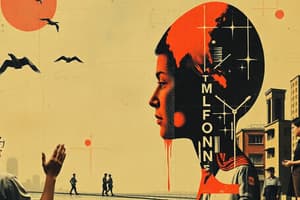Podcast
Questions and Answers
What is the name of the popular dance represented by a pair of warriors staging a fight with bolos, bows and arrows?
What is the name of the popular dance represented by a pair of warriors staging a fight with bolos, bows and arrows?
Duel dance
What material did the ancient Filipinos use to make body ornaments such as beads and bracelets in the New Stone Age?
What material did the ancient Filipinos use to make body ornaments such as beads and bracelets in the New Stone Age?
The spread of Islam to Old Malaysia was brought about by the activities of Arab traders.
The spread of Islam to Old Malaysia was brought about by the activities of Arab traders.
True (A)
What form of government did the Arabs introduce to the Philippines?
What form of government did the Arabs introduce to the Philippines?
Signup and view all the answers
What is the purpose of a graphic organizer in teaching and learning?
What is the purpose of a graphic organizer in teaching and learning?
Signup and view all the answers
What is the main task in Assessment Task 3 - Creating Infographic?
What is the main task in Assessment Task 3 - Creating Infographic?
Signup and view all the answers
Indian influence on Filipino life is primarily shown in the Philippine languages, particularly in __________.
Indian influence on Filipino life is primarily shown in the Philippine languages, particularly in __________.
Signup and view all the answers
What is the basis for rating the 'Required Elements' category in the infographic rubric?
What is the basis for rating the 'Required Elements' category in the infographic rubric?
Signup and view all the answers
Is it important for borrowed pictures in the infographic to have a correct source citation?
Is it important for borrowed pictures in the infographic to have a correct source citation?
Signup and view all the answers
What is the purpose of the picture captions in the infographic?
What is the purpose of the picture captions in the infographic?
Signup and view all the answers
What did the ancient Filipinos use as their system of writing before the arrival of the Spaniards?
What did the ancient Filipinos use as their system of writing before the arrival of the Spaniards?
Signup and view all the answers
How many major languages are considered in the Philippines according to Agoncillo (2012)?
How many major languages are considered in the Philippines according to Agoncillo (2012)?
Signup and view all the answers
Divorce was legal in pre-colonial Philippines.
Divorce was legal in pre-colonial Philippines.
Signup and view all the answers
Before the arrival of the Spaniards, ancient Filipinos wrote on the bark of trees, on leaves, and bamboo tubes using their knives, daggers, or iron as pens and colored ____ of trees as ink.
Before the arrival of the Spaniards, ancient Filipinos wrote on the bark of trees, on leaves, and bamboo tubes using their knives, daggers, or iron as pens and colored ____ of trees as ink.
Signup and view all the answers
Study Notes
Pre-Colonial Philippine Culture
- In pre-colonial Philippines, a woman could obtain a divorce by returning the dowry to the man or his parents with an additional amount equal to the dowry.
- If the couple had children, both the dowry and fine went to the children, which was held in trust for them by the grandparents or responsible relatives.
Early Filipino Literature
- Early Filipinos had written languages that traced their origin to the Austronesian (Malayan-Polynesian) parent stock.
- They used these languages not only as media of daily communication but also as vehicles for the expression of their literary moods.
- Folk literature represented a group heritage and reflected their daily lives.
- They had music and dance for almost all occasions and a wide variety of musical instruments indicative of their ingenuity.
System of Writing
- Ancient Filipinos had a syllabary which was probably of Sanskrit or Arabic provenance.
- The syllabary consisted of seventeen symbols, of which three were vowels standing for the present five vowels and fourteen consonants.
- They wrote on the bark of trees, on leaves and bamboo tubes, using their knives, daggers, pointed sticks or iron as pens and the colored saps of trees as ink.
Early Philippine Music and Dance
- Natives were music lovers and had various percussion instruments such as the timbal, timbrel, cymbal, and drum.
- They also had stringed instruments like the kudyapi, a kind of small guitar.
- The Negritos of Bataan and Zambales had their own musical instruments, including the Jew's harp made of bamboo, bansic made of mountain cane, bamboo violin with abaca strings, and gangsa, a sort of guitar.
Art
- Art started in the first primitive inhabitants of the Philippines through their tools and weapons.
- As time passed, tools and weapons were polished, developed, and formed along the lines of leaves and petals.
- In the New Stone Age, primitive inhabitants started to improve their artistic sense through the use of body ornaments such as beads and bracelets made of green jade, red cornelian, and other attractive stones.
Cultural Influences
- Arabs introduced Islam to the indigenous people, making Mindanao an Islamic and sacred island.
- Arabs also introduced the sultanate form of government, where a sultan is the main chief in charge.
- Chinese influences are reflected in the economy, with the introduction of umbrellas, gongs, lead, porcelain, gunpowder, mining methods, and metallurgy.
- Indians influenced Filipino languages, particularly Tagalog, with a large number of terms of Sanskrit origin.
- Indian influence is also seen in ancient Filipino customs, such as arranging marriages of children by parents, and mourning customs.### Philippine History: Pre-Colonial Period
Assessment Tasks
- Three assessment tasks for evaluating understanding of Philippine Pre-Colonial Culture
- Task 1: Identify three words that best describe Philippine Pre-Colonial Culture and explain why
- Task 2: Create a concept map to show how Arabs, Chinese, and Indians influenced Philippine Culture
- Task 3: Produce a well-designed infographic on cultural influences brought by Arabs, Chinese, and Indians during the pre-colonial period
Task 1: Identifying Philippine Pre-Colonial Culture
- Basis for rating: words used in describing Philippine Pre-Colonial Culture (30 points) and supporting details (45 points)
- Guidelines for answering:
- Understand the statement/question
- Organize thoughts
- Include relevant facts
- Use correct grammar and punctuation
- Write legibly and neatly
Task 2: Concept Mapping
- Basis for rating: completeness of concept map (100 points)
- Guidelines for creating a graphic organizer:
- Craft a graphic organizer to show relationships between concepts, terms, and facts
- Explain how each contribution from Arabs, Chinese, and Indians has created an impact on Philippine Culture
Task 3: Creating Infographic
- Basis for rating: design and content of infographic (20 points each for required elements, relevance of pictures and captions, mechanics, and attractiveness)
- Guidelines for creating an infographic:
- Use relevant and focused pictures and captions
- Include all required elements
- Ensure pictures and captions are related to the topic and have a source citation
- Use correct capitalization and punctuation
- Design an attractive and well-organized infographic
Studying That Suits You
Use AI to generate personalized quizzes and flashcards to suit your learning preferences.
Related Documents
Description
A quiz on Philippine popular culture, covering various aspects of Filipino culture and society. Designed for students of Talisay City College.




